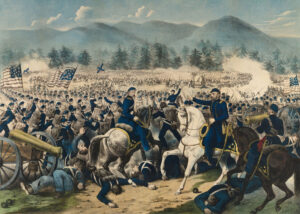Ox Hill: Honoring 2nd Bull Run’s bloody postscript
Not too long ago, if you drove down one crowded stretch of Route 608 in Fairfax County, Virginia, it was easy to miss a ragged plot of land called Ox Hill Battlefield Park.
That is no longer the case, thanks to preservationist Ed Wenzel and a loyal group of volunteers. On September 1— the 146th anniversary of the Battle of Ox Hill (Chantilly)— Wenzel was among several representatives who christened the newly refurbished Ox Hill Battlefield Park at the corner of West Ox Road (Route 608) and Monument Drive.
The often-overlooked battle was fought during a blinding thunderstorm on September 1, 1862,two days after the Second Battle of Bull Run—the only major engagement to take place in Fairfax County. About 15,000 Confederates under such famed generals as Thomas “Stonewall” Jackson, A. P. Hill, J. E. B. Stuart and Maxcy Gregg squared off against 6,000 Federal troops. The Union would lose two of its most revered generals in heroic fashion that day: Isaac Stevens and the one-armed Philip Kearny.
The battle ended in a draw, but the Federals succeeded in protecting General John Pope’s army as it retreated to Fairfax Court House.
Concerned that the battlefield was unprotected and in disrepair, Wenzel joined forces in 1986 with Brian Pohanka and Clark “Bud” Hall to form the Chantilly Battlefield Association (CBA).At the time, developers owned nearly all of the battlefield’s original 500 acres and intended to move two monuments dedicated to Kearny and Stevens to a proposed small “historic park” nearby. The developers eventually agreed to help establish the park on a 2.4- acre parcel of land surrounding the monuments. The CBA also hounded government officials to purchase an adjacent 2.4-acre lot that doubled the park’s size.
Now that the park has been spruced up with split-rail fencing and interpretive markers, efforts are under way to re-create a portion of a cornfield where Kearny was killed. Wenzel said he hopes two new monuments to the Union and Confederate forces that fought there will be finished and in place by the battle’s 2012 sesquicentennial.
“Our goal was to save what we could and re-create a 19thcentury Civil War landscape in the midst of modern, urban Fairfax,” Wenzel said. “The Ox Hill park may be small, but it will take you back in time to that stormy day in history when a small fight changed history.”
–Chris Howland
She got his house when he bought the farm
With the recent death of Maudie White Hopkins, the last publicly known widow of a Confederate soldier, the nation might have lost its last direct link to the men who fought in the Civil War. Hopkins died in August in her home state of Arkansas. She was 93.
Hopkins married Confederate veteran William M. Cantrell in 1934 when she was 19 and he was 86. She had been doing chores and cleaning house for the widowed Cantrell when he proposed marriage, offering to bequeath her his land and home if she would care for him in his twilight years.
After discussing the matter with her large family—which was so poor her father once made shoes out of old rubber tires—she agreed to the arrangement. Cantrell died three years later after falling from a mule.
In a 2004 Associated Press article, Hopkins called her late husband a “good, clean, respectable man.”
“Maudie never talked about her marriage to Cantrell that much, because she thought that people would not look kindly on this 19-year-old girl marrying this old man,” said Martha Boltz, a member of the United Daughters of the Confederacy who has uncovered most of the known facts of Hopkins’ life.
Hopkins later married three more times and had three children. She was a “charming little old lady,” Boltz recalled.
Alberta Martin, who passed away in 2004, had been touted as the last living widow of a Confederate soldier before Hopkins agreed to go public with her story. Boltz knows of “two or three” other Confederate widows who are still living, but wish to remain out of the spotlight.
The last known Union widow, Gertrude Janeway, died in 2003.With the “discovery” of Maudie White Hopkins, however, one wonders how many more may still survive.
–Kim A. O’Connell
Museum of the Confederacy plans expansions to three sites
Although the number of visitors to its Richmond location has declined over the years, officials at the Museum of the Confederacy hope that opening three new Virginia facilities during the Civil War sesquicentennial, with the first in Appomattox, will spur interest in the museum’s vast collection.
A significant portion of the collection will remain in Richmond, according to museum director S. Waite Rawls III. Only 10 percent of the museum’s collection is currently displayed; once the other facilities open (pending financing and necessary approvals), roughly 40 percent will be on view, Rawls said, including a number of flags, uniforms and weapons, as well as new multimedia exhibits. Along with Appomattox, museums are planned for Fredericksburg and Fort Monroe, near Norfolk
“The four locations tell what I consider the four great stories of the war,” Rawls said. “Richmond represents the rending of the nation and the creation of a new government, Fredericksburg tells the story of the war itself and combat, Fort Monroe [a Union stronghold that welcomed escaped slaves] is the best place to tell the story of slavery and emancipation, and Appomattox represents the war’s end and the reunification of the country.”
The town of Appomattox is eager for its new museum and has signed a contract to purchase a four-acre tract of land only 400 yards from Appomattox Court House National Historical Park, which it will lease to the museum. Pending approval of the plan—which must go through a public hearing process—museum officials aim to begin construction in 2009 and open in spring 2011. Proposed exhibits will feature the uniform and sword worn by Robert E. Lee at the surrender as well as several flags laid down there, among other artifacts.
–Kim A. O’Connell
Lincoln stayed at this Gettysburg address
As the Lincoln bicentennial begins nationwide, the long-awaited grand opening of the David Wills House in Gettysburg—the site where President Lincoln edited and polished his famed Gettysburg Address—will occur February 12-16, 2009.
Previews of the house were scheduled for November 18- 22, 2008, to commemorate the 145th anniversary of the speech.
Wills, a lawyer and prominent local citizen, had invited Lincoln to deliver a few remarks at the dedication of the national cemetery at Gettysburg and to stay in his elegant home on the town square the night before. There, in a second-floor bedroom of the three-story, brick Federal-style house, Lincoln is thought to have put the final touches on the 272-word address that he believed the world would “little note, nor long remember.” The circa-1816 house is included on the National Register of Historic Places.
In February, following a $6.6 million rehabilitation, the Wills House will reopen as a downtown visitor center and new museum about Abraham Lincoln and the Gettysburg Address that will be part of Gettysburg National Military Park. The museum will feature six galleries, including the restored office where Wills coordinated post-battle recovery efforts and the bedroom where the most famous speech in American history was completed.
Main Street Gettysburg will operate the museum in cooperation with the National Park Service. Visit nps.gov/gett or mainstreetgettysburg.org for more information.
–Kim A. O’Connell
Gettysburg witness tree—battered yet standing
On August 7, a sudden squall damaged 70 to 80 percent of the honey locust tree that stands just 150 feet from the site where Abraham Lincoln delivered his Gettysburg Address. The tree is one of several so-called witness trees that stood on the battlefield in 1863, and park officials believe many more exist that have not been identified.
The storm damage was so severe that a widely distributed Associated Press article indicated that the tree had fallen. But while the tree’s crown was shorn off, much of the trunk and several large branches survived. The park is now rehabilitating the tree in the hope that it will endure over the long term.
“We are going to have some careful trimming done to smooth off the jagged edges on the remaining trunks, and we also might take some weight off here and there to improve the balance and safety of the tree,” says Katie Lawhon, a spokesperson for Gettysburg National Military Park.
During the ongoing restoration of the battlefield to its 1863 appearance, park staffers ensure that identified witness trees are preserved. The National Park Service has already donated wood from the damaged sections of the tree to the Gettysburg Foundation, its nonprofit partner. The foundation is now considering ways to use the historic wood to raise money for further battlefield preservation.
Richmond’s slave history uncovered
Between 1800 and 1865, the city of Richmond, Va., witnessed the trafficking of an estimated 300,000 slaves. Modern development has erased much of that history, but a new archaeological excavation aims to uncover evidence of the city’s slave-trading past.
A team from the James River Institute for Archaeology, led by senior researcher Matthew Laird, began digging in August at the site of the former Lumpkin’s Slave Jail—an infamous slave-holding center that reportedly had a “whipping room.” The project is sponsored by the Richmond Slave Trail Commission, a city council-appointed panel working to identify and link key sites related to slavery.
“We know Lumpkin’s was one of the largest slave jails that existed in the city of Richmond,” says Steven Skinner, a spokesman for the city council. “And, of course, Richmond had one of the largest slave export businesses in the United States.”
The evolution of Lumpkin’s jail took an ironic twist. Proprietor Robert Lumpkin ultimately married a former slave woman named Mary, who inherited the jail after his death. She leased it to a Northern clergyman who established a school for freed slaves on the site, which eventually became Virginia Union University.
Laird hopes the dig will uncover not only the jail’s structural foundations but also artifacts related to the slave-trading period—which will be documented and mapped and, in some cases, turned over to the state for interpretation.
–Kim A. O’Connell
Originally published in the January 2009 issue of America’s Civil War. To subscribe, click here.




